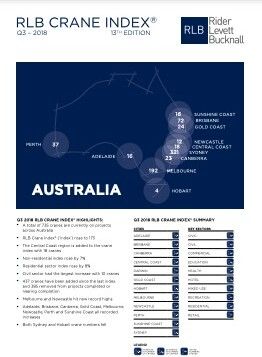Australia’s ongoing construction boom now has an unprecedented 735 long-term cranes standing tall across our city skylines, according to the Rider Levett Bucknall Q3 2018 RLB Crane Index® released today. This equates to an increase of 52 cranes (+7%) compared to the last count undertaken six months ago.
Melbourne saw a strong 35 crane increase to reach a new peak of 192, overtaking the record levels reached six months earlier. Meanwhile, Sydney continues to decline from the peak reached in Q4 2017, driven by a declining residential sector.
Civil sector a star performer
RLB Global Chairman Stephen Mee said, ‘While we see Australian construction activity reach record numbers, the infrastructure (civil) sector has been the star performer of the past 6 months with a 67% increase in crane numbers.’
He added, ‘From a base of 15 cranes on infrastructure projects in Q2 2018, 19 new cranes were erected on projects during the past 6 months while 9 were dismantled, giving a total of 25 cranes for 3Q 2018. With the announcement of many significant infrastructure projects by both Federal and State Governments, the anticipation is for civil cranes to maintain current levels or rise further.’
According to the RLB Crane Index®, Melbourne has seen 13 new civil cranes added from a base of zero six months ago and Sydney has seen a rise from eight to 11 cranes. Key infrastructure projects in these cities include the Metro Tunnel’s enabling works in North Melbourne (6), the Westgate Tunnel project (5), Sydney Metro’s Bella Vista station (2) and the West Connex tunnel at Kingsgrove (2).
Statistics show strength of construction industry ongoing
Recent construction statistics released by the Australian Bureau of Statistics highlight the ongoing strength of the overall construction industry. For FY 2018, total construction in Australia reached $221 billion. Strong increases were seen in the non-residential and engineering construction sectors of 11.1% and 20.7% respectively, while the residential building sector remained constant at $74 billion.
Non-residential continues its rise
As building work done for apartments continues to rise, with a 2.3% increase for FY 2018, there appears to be a bounce in the residential crane index from its dip in Q2 2018. Nationally, the number of residential cranes increased in all regions, except Sydney and Newcastle, lifting the national residential index by 8% to 170. Additionally, the non-residential index continued its rise, increasing 7%, recording a new high of 180.
Sydney still the main driver of crane count
According to the RLB Crane Index®, Sydney continues to be the main driver of the crane count. Of the 735 cranes sighted across Australia, 321 were in Sydney, 192 were in Melbourne, 72 were in Brisbane, 37 were in Perth, 24 were on the Gold Coast, 23 were in Canberra, 16 were in both Adelaide and the Sunshine Coast, 12 were in Newcastle and 4 were in Hobart.
For the first time, the RLB Crane Index® includes the Central Coast in New South Wales, which had 18 cranes sighted.
Civil sector leading rise in Melbourne
Melbourne’s crane numbers have seen a jump, increasing by 35 cranes. Driving this rise is the civil sector with the introduction of 13 new cranes. All other sectors remained strong, either maintaining or increasing cranes from the count six months ago.
Sydney residential declining as Brisbane bounces back
Since its previous peak of 350 in Q3 2017, Sydney’s crane count has been falling, driven by a declining residential sector. The residential crane count has fallen by 55 cranes from its peak in Q4 2017.
Brisbane has bounced back from its dip in the last edition, driven by a rise in mixed use projects. While the residential sector remained stable, 11 new cranes were added to the mixed-use sector.
For further details of crane activity in each Australian city, please refer to the 3Q 2018 RLB Crane Index.
FURTHER INFORMATION:



